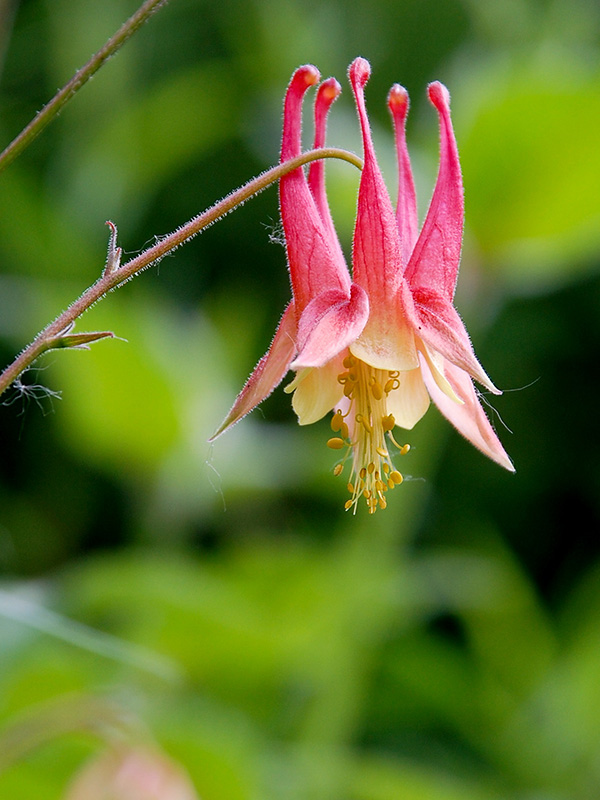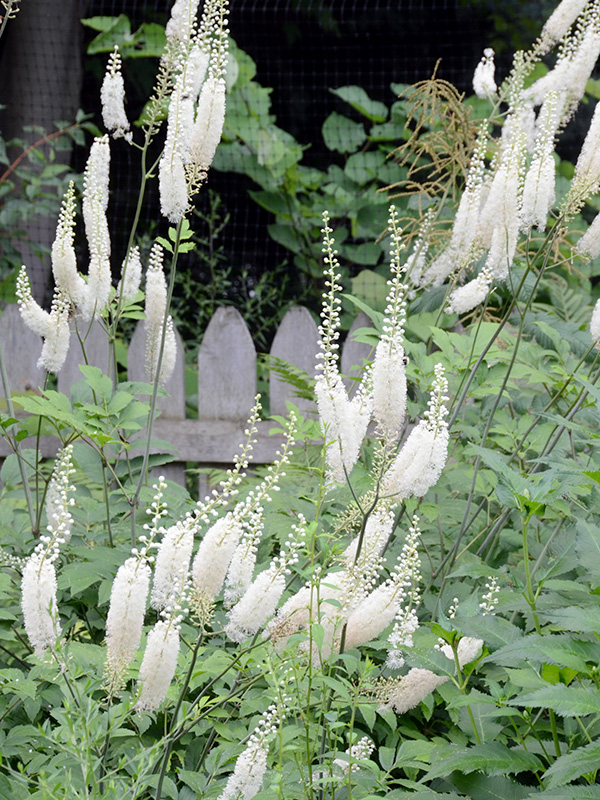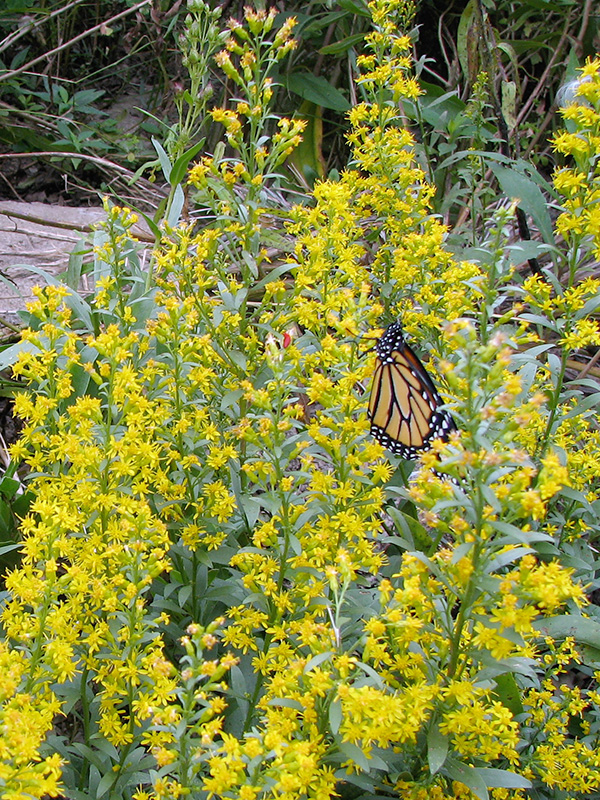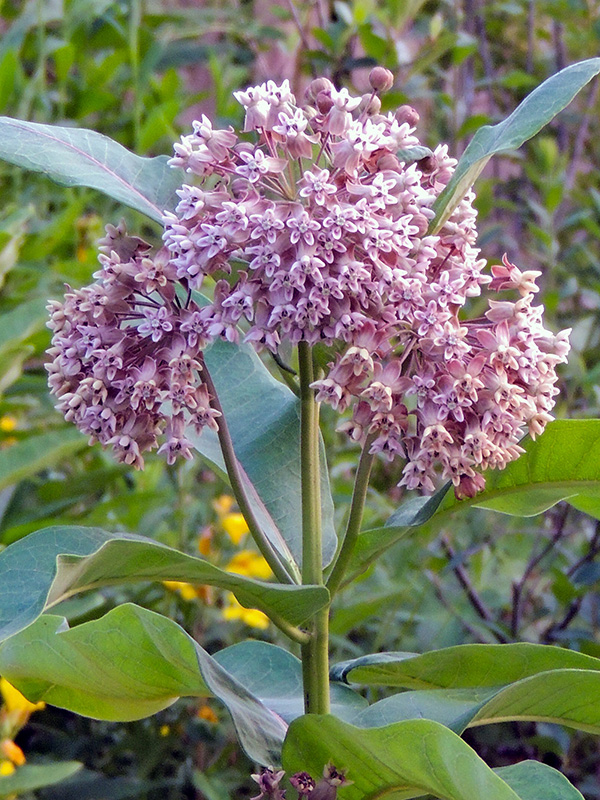
Everyone knows that plants are what gardens are all about.
BUT not everyone understands how plants are essential for wildlife and, indeed are the foundation of life on earth — including for humans. They’re not merely pretty decorations for our yards!
We think about four kinds of plants when we choose plants for our habitat garden:
- Dead plants (Yes, you read that right!)
- Native plants
- Non-native plants that are NOT invasive
- Invasive non-native plants
Helpful tips about plants
I’ve found that knowing the botanical (i.e. scientific) names is very handy.

For example, the common name of this plant is “black cohosh” or “bugbane.” If you know that regardless the common name, it’s actually Cimicifuga racemosa, it eliminates confusion.
Although I have to admit that sometimes change the official scientific name as they uncover genetic similarities with another group of plants. Oh well.
And what about cultivars and hybrids? What are they? Are they okay to have in a habitat garden?
And since people often have difficulty finding information about native plants, I’ve included my favorite web resources and reference books.
Two underappreciated and misunderstood plants
We have many, many different kinds of goldenrods and milkweeds in our habitat garden. Not only are they important as habitat plants, but they’re also beautiful additions to our garden. Unfortunately, these plants are misunderstood and underappreciated.
Goldenrods

Goldenrods (Solidago) are an important source of nectar for migrating butterflies and for bees. Even so, people are reluctant to plant them because they MISTAKENLY believe that:
- goldenrods are the source of seasonal allergies
- the common Canada goldenrod (S. canadense), which can be especially rambunctious, IS goldenrod
BUT …
Allergies: People do sneeze sometimes when they’re around goldenrods, BUT that’s often because other allergy-inducing plants are growing near the goldenrods. If the rather nondescript ragweed is growing next to the brilliant yellow goldenrod, which one will you notice? More about goldenrods, including the science regarding allergies.
Types of goldenrod: The common Canada goldenrod is an important nectar plant, but so are many other beautiful goldenrods. We grow many different kinds of the genus Solidago (see our list of wildflowers).
Milkweed

Mention milkweed and people often picture common milkweed (Asclepias syriaca), running rampant in the wild.
They may or may not know that milkweeds are an essential host plant for monarch butterflies, but they do know that they don’t want a “weed” growing in their garden.
We happen to grow some common milkweed in our yard in a few defined locations. We keep an eye on it since it can indeed spread by underground rhizomes, but we haven’t experienced any real problems. We just pull out stems that come up where we don’t want them. And we truly enjoy their heavily-scented flowers — one of my favorite fragrances.
But what people don’t know is that there are many other kinds of native milkweeds, most of which are fine garden-worthy plants. Most of these are also important host plants for the monarch butterfly. See what kinds of milkweeds we grow.
Resources
- Wild Ones:
- Native Plant Trust:
- Biota of North American Program (BONAP):
- You can check on the range of any plant, native or invasive
- New York Flora Association:
- New York Flora Atlas – Check the “native” filter for plants native to NYS
- Native Plant Conservation Campaign:
- SUGi:
- BBC:
- NY Times:
- Wild Seed Project:
- Science News:
- To the Best of Our Knowledge:
- AUDIO and article: We’ve forgotten how to listen to plants – With Robin Kimmerer!!
- AUDIO: We share this world with plants. What do we owe them?
- USDA: NRCS – Connecticut:
- Grow Native Massachusetts – Dr. Gegear:
- VIDEO: More than just the buzz: Finding real solutions to native pollinator decline – We must protect pollinators (esp. specialists) to protect plants that depend on them
- BBC:
- VIDEO: Nature’s Life in the Undergrowth with Richard Attenborough: How galls are formed – a 5-min video. Fascinating!
- PBS The Green Planet: Excellent series!! Once past the streaming date, you’ll need a PBS Passport from your local PBS station (worth the $60 to support public media and see years worth of great programs) or get the DVDs from your local library
Reflections
Your garden has a function. In the past we have not designed gardens that play a critical ecological role in the landscape, but we must do so in the future. The importance of our doing this cannot be overstated. We need to quickly replace unnecessary lawn with densely planted woodlots in the East and West, and natural prairies in the Midwest; whatever can serve as habitat for our local biodiversity. Homeowners can do this by planting the borders of their properties with plants native to their region: In the East, native trees such as white oaks (Quercus alba), black willows (Salix nigra), red maples (Acer rubrum), green ashes (Fraxinus pennsylvanica), black walnuts (Juglans nigra), river birches (Betula nigra) and shagbark hickories (Carya ovata), under-planted with woodies like serviceberry (Amelanchier canadensis), arrowwood (Viburnum dentatum), hazelnut (Corylus americanus), and blueberries (Vaccinium spp). Our studies have shown that even modest increases in the native plant cover on suburban properties significantly increases the number and species of breeding birds, including birds of conservation concern.
~ Doug Tallamy, Gardening for Life, an article published in Wild Ones Journal (Download the entire article from the HGCNY Wild Ones chapter)
The same two species [goldenrod and milkweed] grow on my place. They grow here because I planted them. But I’m free to stand by while they die of neglect or even to kill them outright if I want. Because they’re mine: I own the land. How strange a notion! The perception of ownership isn’t shared by any of the creatures who live on the land, or from it, or cross over it. I own the plants, but not the relationships by which their roots are nourished, or their flowers pollinated, or their seeds dispersed. I own the dirt, but not the living systems that maintain it. Yet ownership gives me license to harm all these things that don’t belong to me. This thought was strange enough in intimate surroundings, touching the goldenrod’s velvet leaves, stroking the milkweed’s silk. It became more uncanny still as I watched the whole width of the continent, coast to coast, all owned, every acre of it, slide slowly beneath the belly of the airplane bound for California. Conservation departments, nature preserves, the very law of the land, can’t protect your lot or mine. It’s up to us to do it of our own free will because we understand that the land is not our own but only in our keeping.
~ Sara Stein, Planting Noah’s Garden pp. 16-17
Yards and gardens patched with grass and stitched with hedges all across America constitute a vast, nearly continuous, and terribly impoverished ecosystem for which we ourselves, with our mowers, shears, and misguided choice of plants, are responsible. We cannot in fairness rail against those who destroy the rain forest or threaten the spotted owl when we have made our own yards uninhabitable. Yet how quickly we could grow this land, spangle it with blazing stars, stripe it with red winterberries and white summersweet, let it wave again with grass!
~ Sara Stein, Noah’s Garden: Restoring the Ecology of Our Own Back Yards, pp. 18-19, 1993
Plants are the basis for life on Earth. Plant communities translate the geophysical variation of the land, such as soil and topography, into the living habitats that sustain life. Conserving multiple intact examples of every habitat is a strategy for sustaining the natural benefits plants provide and maintaining the full diversity of species that depend on them.
~ Native Plant Trust’s report “Conserving Plant Diversity in New England“
